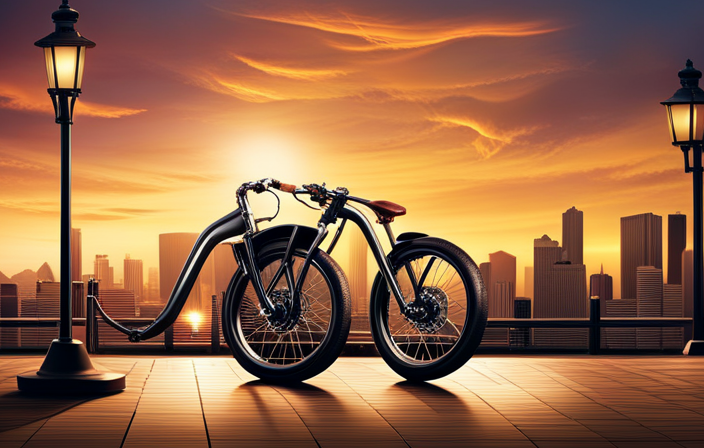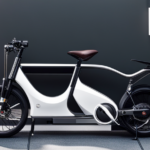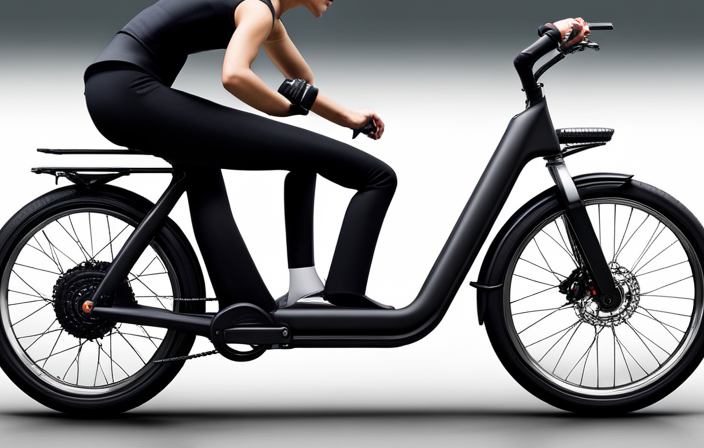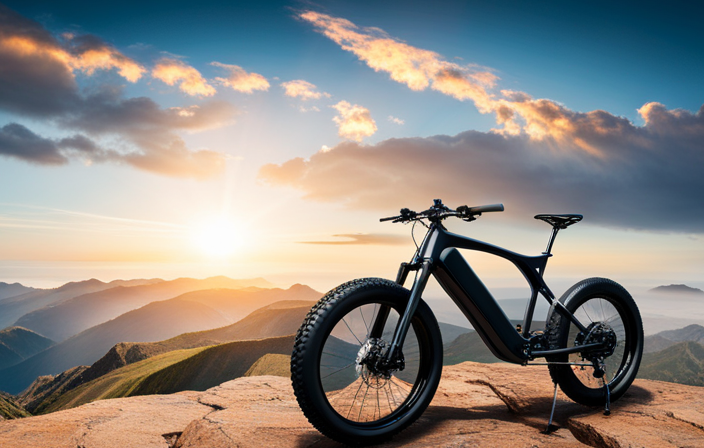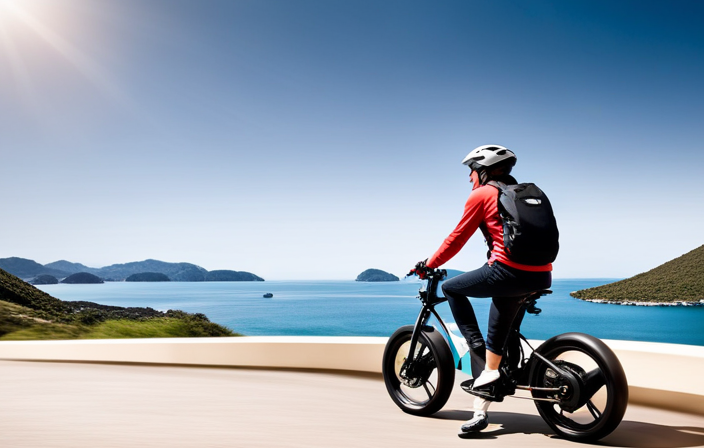As an avid electric bike rider, I’ve always been curious about how much electricity these eco-friendly vehicles consume. In this article, we’ll delve into the technical aspects of electric bikes and analyze the data to answer the burning question: how much electricity does an electric bike use?
By understanding the basics of electric bike operation, battery capacity and range, as well as the factors that affect electricity consumption, we can make informed choices for sustainable transportation.
Let’s explore the fascinating world of electric bike electricity consumption together.
Key Takeaways
- Electric bikes use electricity to assist pedaling, with power ranging from 250 to 750 watts.
- Factors such as terrain, rider weight, cargo, and speed affect the energy consumption of electric bikes.
- Electric bikes consume significantly less energy than cars and are more energy efficient than public transportation.
- Electric bikes have a lower carbon footprint compared to cars, emitting an average of 22 grams of CO2 per kilometer, while cars emit 271 grams.
The Basics of Electric Bikes
Electric bikes, also known as e-bikes, use electricity to assist the rider while pedaling. Understanding motor power is crucial when it comes to electric bikes.
The power of an electric bike is usually measured in watts and can range from 250 watts to 750 watts or even higher. Higher wattage means more power, allowing the bike to go faster and tackle steeper hills with ease.
The advantages of electric bikes are numerous. They provide a boost to your pedaling efforts, making it easier to ride longer distances or commute to work without breaking a sweat. Electric bikes also offer a greener alternative to traditional transportation methods, as they produce zero emissions.
Now, let’s delve into how electric bikes work and explore their inner workings.
How Electric Bikes Work
An electric bike operates by utilizing a battery-powered motor. This motor provides assistance to the rider, making it easier to pedal and allowing for higher speeds. Electric bikes require regular maintenance to ensure optimal performance. This includes checking the battery, tires, brakes, and other components. Additionally, understanding how an electric bike functions can help riders maximize its efficiency and lifespan. Proper charging habits and routine inspections play a crucial role in preventing potential issues. By keeping all components in good condition, an electric bike functions smoothly and provides a reliable mode of transportation.
One of the main benefits of electric bike commuting is its efficiency. Electric bikes are an eco-friendly mode of transportation that can help reduce carbon emissions and traffic congestion. They also provide a cost-effective alternative to traditional vehicles, saving money on fuel and parking.
Understanding battery capacity and range is crucial for electric bike owners. This knowledge allows riders to plan their trips accordingly and ensure they have enough power to reach their destination.
Transitioning into the next section, let’s delve into the intricacies of battery capacity and range.
Understanding Battery Capacity and Range
Understanding the battery capacity and range of an electric bike is essential for planning trips and ensuring sufficient power to reach your destination. When it comes to electric bikes, the battery is the heart of the machine.
Battery lifespan is an important factor to consider, as it determines how long the battery will maintain its capacity to hold a charge. To optimize battery performance, it is recommended to keep the battery between 20% and 80% charged, avoiding extreme temperatures and deep discharges. Additionally, regular maintenance, such as cleaning and proper storage, can help prolong the battery’s lifespan.
The battery’s capacity and range are also influenced by factors like terrain, rider weight, and speed. These factors will be further explored in the next section about factors that affect electricity consumption.
Factors that Affect Electricity Consumption
To optimize your electric bike’s battery life and range, it’s important to consider the factors that can affect how much power you consume.
Several factors can impact the amount of electricity your electric bike uses. Firstly, the charging method you use can have a significant effect. Fast charging may consume more electricity compared to slow charging, but it can also reduce battery lifespan.
Additionally, the terrain you ride on plays a role. Uphill rides require more power, while flat terrain consumes less.
Other factors include the weight of the rider and any cargo being carried, as well as the speed at which you ride.
It’s important to note that the electricity consumed by an electric bike may have an impact on your monthly electricity bills.
Understanding these factors will help you make informed decisions about your electric bike’s energy consumption.
Moving on to calculating the energy consumption of an electric bike…
Calculating the Energy Consumption of an Electric Bike
To calculate the energy consumption of your electric bike, you need to consider factors like the charging method, terrain, rider weight, cargo, and riding speed. Each of these components contributes to the overall efficiency of the bike. For instance, the charging method affects energy consumption because different systems have varying levels of efficiency. Similarly, riding on hilly terrain requires more energy compared to flat surfaces. Additionally, rider weight and cargo can increase energy usage as the motor has to work harder. Moreover, riding at higher speeds consumes more energy due to increased wind resistance. By taking these factors into account, you can estimate the energy consumption of your electric bike and make informed decisions about its usage.
When comparing electric bikes to other modes of transportation, it is important to consider their energy efficiency. Electric bikes are known for being more energy-efficient compared to other options.
Comparing Electric Bikes to Other Modes of Transportation
When comparing electric bikes to other modes of transportation, it’s important to consider their energy efficiency. Electric bikes have several advantages over cars in terms of energy consumption. Here are three key points to consider:
-
Electric bikes consume significantly less energy compared to cars. While the exact energy consumption varies depending on factors such as speed and terrain, electric bikes typically use around 0.1 kilowatt-hours per kilometer, whereas cars can use anywhere from 0.2 to 0.6 kilowatt-hours per kilometer.
-
Electric bikes are also more energy efficient than public transportation. Buses and trains require a large amount of energy to transport multiple passengers, whereas electric bikes only require energy for a single rider. This makes electric bikes a more sustainable and environmentally friendly option.
-
Additionally, electric bikes offer the benefit of reducing traffic congestion. With their ability to navigate through traffic jams and take shortcuts, electric bikes can save both time and energy compared to being stuck in a car or waiting for public transportation.
Considering these factors, electric bikes prove to be a more energy-efficient and practical mode of transportation compared to cars and public transportation.
Moving forward, it is important to evaluate the environmental impact of electric bikes.
The Environmental Impact of Electric Bikes
If you’re concerned about the environmental impact, it’s important to consider the emissions and carbon footprint of electric bikes. Government regulations play a crucial role in ensuring that electric bikes adhere to emission standards. Compared to other modes of transportation, electric bikes have significantly lower carbon emissions. A study conducted by the European Cyclists’ Federation found that electric bikes emit an average of 22 grams of CO2 per kilometer, while cars emit 271 grams of CO2 per kilometer. This substantial difference in carbon emissions makes electric bikes a greener option for transportation.
| Mode of Transportation | Carbon Emissions (grams CO2/km) |
|---|---|
| Electric Bike | 22 |
| Car | 271 |
| Bus | 107 |
| Train | 41 |
| Bicycle | 0 |
Considering these statistics, it’s clear that electric bikes have a minimal environmental impact compared to other modes of transportation. Now, let’s delve into the process of charging an electric bike.
Charging an Electric Bike
When it comes to charging an electric bike, two key points to consider are the charging time and the methods used.
The charging time varies depending on the battery capacity and the charging method, with most electric bikes taking between 3 to 6 hours for a full charge.
As for the charging methods, they can range from using a standard wall outlet to using fast-charging stations or even solar panels.
Additionally, using renewable energy sources for charging electric bikes is a sustainable option that can further reduce the environmental impact of transportation.
Charging Time and Methods
To charge your electric bike, you can use different methods and it will take varying amounts of time.
Fast charging is one option, which allows you to charge your bike quickly, usually within a couple of hours. This method is convenient when you’re in a hurry or need to quickly top up your battery.
Another method is solar power charging, which utilizes the energy from the sun to charge your electric bike. This method is environmentally friendly and can be a great option if you have access to sunlight. The charging time for solar power charging can vary depending on the intensity of sunlight and the efficiency of the solar panels.
Transitioning into the subsequent section about using renewable energy sources, it is important to explore sustainable options for charging electric bikes.
Using Renewable Energy Sources
Renewable energy sources provide a sustainable option for charging electric bikes. By transitioning to clean energy, we can reap numerous benefits and reduce our carbon footprint. Here are three sub-lists to illustrate the advantages of using renewable energy sources:
-
Solar power: Harnessing the sun’s energy through photovoltaic panels not only eliminates greenhouse gas emissions but also offers unlimited potential for charging electric bikes.
-
Wind power: Using wind turbines to generate electricity is another viable option for charging electric bikes. Wind energy is abundant and widely available, making it a reliable and sustainable choice.
-
Hydroelectric power: By utilizing the power of flowing water, hydroelectric systems can generate electricity to charge electric bikes. This renewable energy source is particularly advantageous in areas with access to rivers or other water sources.
Transitioning to renewable energy sources not only benefits the environment but also maximizes the energy efficiency of electric bikes. By incorporating these sustainable charging methods, we can optimize our electric bike usage while minimizing our impact on the planet.
Tips for Maximizing the Energy Efficiency of Your Electric Bike
For better energy efficiency, make sure you’re maintaining the proper tire pressure on your electric bike. This simple step can significantly improve the overall performance and reduce energy consumption. In addition to tire pressure, there are several energy-saving techniques and efficient riding techniques that can maximize the energy efficiency of your electric bike. By adopting a smooth and steady riding style, avoiding sudden acceleration and braking, and using pedal-assist mode whenever possible, you can conserve energy and extend the battery life of your electric bike. Furthermore, optimizing your route, avoiding steep hills, and reducing wind resistance by tucking in your elbows and knees can also contribute to energy savings. Implementing these strategies will not only save energy but also enhance your riding experience. Transitioning into the subsequent section about ‘the cost of charging an electric bike,’ it is important to consider the financial implications of owning and operating an electric bike.
The Cost of Charging an Electric Bike
Now that we have discussed some tips for maximizing the energy efficiency of your electric bike, let’s delve into the cost of charging it.
As an electric bike owner, it is essential to consider the expenses associated with charging your bike’s battery. By implementing cost-saving tips and comparing different charging methods, you can effectively manage your electric bike’s charging expenses.
One cost-saving tip is to charge your electric bike during off-peak hours when electricity rates are typically lower. Additionally, you can explore alternative charging methods, such as solar or wind power, to further reduce your electricity costs.
By being mindful of these factors, you can ensure that charging your electric bike remains affordable.
Moving forward, let’s explore the affordability of electric bikes and how they compare to traditional bicycles.
The Affordability of Electric Bikes
To determine if an electric bike is affordable for you, consider factors such as your budget and the potential long-term savings.
Affordability challenges may arise due to the upfront cost of purchasing an electric bike, which can be higher than a traditional bike. However, it is important to consider the economic benefits that come with owning an electric bike.
Electric bikes have lower operating costs compared to cars or motorcycles, as they require less maintenance and do not rely on expensive fossil fuels. Additionally, the cost of charging an electric bike is significantly lower than refueling a gas-powered vehicle. These factors can lead to substantial long-term savings.
As we look into the future of electric bikes and sustainable transportation, it is clear that affordability plays a crucial role in encouraging their widespread adoption. Transitioning to electric bikes can contribute to a more sustainable and eco-friendly transportation system.
The Future of Electric Bikes and Sustainable Transportation
Consider the potential impact of electric bikes on sustainable transportation and how they can contribute to a more eco-friendly future. As technology continues to advance, the future of electric bikes looks promising. With ongoing research and development, we can expect to see improvements in battery efficiency, range, and charging time. These advancements will make electric bikes even more appealing and accessible to a wider range of individuals.
Moreover, the impact of electric bikes on urban planning cannot be overlooked. With the growing popularity of electric bikes, cities may need to adapt their infrastructure to accommodate the increasing number of cyclists. This could include the creation of dedicated bike lanes and charging stations.
Overall, electric bikes have the potential to revolutionize transportation and create a more sustainable future. Transitioning to the subsequent section about government incentives and policies supporting electric bike adoption, it is crucial to analyze the role these factors play in promoting the widespread use of electric bikes.
Government Incentives and Policies Supporting Electric Bike Adoption
You can explore the various government incentives and policies that support the adoption of electric bikes.
Governments worldwide have recognized the potential of electric bikes to reduce carbon emissions and alleviate traffic congestion. To encourage their use, many governments offer financial incentives such as tax credits, rebates, and subsidies for purchasing electric bikes. Additionally, some cities provide grants to businesses that offer electric bike sharing programs. These government incentives aim to make electric bikes more affordable and accessible to the general public, thereby promoting their widespread adoption.
In addition, certain policies have been implemented to support electric bike infrastructure, such as the establishment of dedicated bike lanes and charging stations. By implementing these measures, governments hope to encourage more people to switch to electric bikes as a sustainable mode of transportation.
Transitioning to the next section, it is important to address common myths and misconceptions about electric bike electricity consumption.
Common Myths and Misconceptions about Electric Bike Electricity Consumption
Now that we have explored the various government incentives and policies supporting electric bike adoption, it’s time to address some common misconceptions about electric bike electricity consumption.
There are many myths surrounding how much electricity an electric bike uses, and it’s important to debunk these misconceptions with data-driven analysis. Contrary to popular belief, electric bikes are incredibly energy-efficient and consume minimal electricity.
On average, an electric bike uses around 0.5 to 1 kilowatt-hour (kWh) of electricity per 100 kilometers. This is significantly lower than the energy consumption of other modes of transportation, such as cars or motorcycles.
By understanding the true electricity consumption of electric bikes, we can make informed choices for sustainable transportation.
Now, let’s move on to the conclusion: making informed choices for sustainable transportation.
Conclusion: Making Informed Choices for Sustainable Transportation
In conclusion, it is crucial to have accurate information about energy-efficient transportation options in order to make sustainable choices. When it comes to electric bikes, understanding their electricity consumption is key. By choosing electric bikes, individuals can contribute to a more sustainable future.
Here are some benefits of electric bikes:
- Reduced carbon emissions: Electric bikes produce zero tailpipe emissions, making them an environmentally friendly alternative to traditional bikes or cars.
- Cost-effective: Electric bikes have lower operational costs compared to cars or motorcycles, saving users money on fuel and maintenance.
- Health benefits: Riding an electric bike provides exercise and promotes a healthier lifestyle.
- Increased accessibility: Electric bikes enable people of all ages and fitness levels to travel longer distances and tackle challenging terrains.
By considering these factors, individuals can make informed choices and contribute to a greener and more sustainable transportation system.
Frequently Asked Questions
Are electric bikes more expensive to charge compared to traditional bicycles?
Electric bikes are more expensive to charge compared to traditional bicycles due to the cost of electricity and the need to replace electric bike batteries. This cost is an additional expense that traditional bikes do not have.
How long does it take to fully charge an electric bike battery?
It takes an average of 4-6 hours to fully charge an electric bike battery. Factors affecting charging time include battery capacity, charger output, and the initial battery charge level.
Can I use a regular power outlet to charge my electric bike?
Yes, it is safe to leave an electric bike charging overnight using a regular power outlet and a portable charger. However, it is important to ensure that the charger is compatible with the bike’s battery specifications to avoid any potential safety hazards.
Will using the pedal-assist feature on an electric bike consume more electricity?
Using the pedal-assist feature on an electric bike will have a significant impact on the battery life. It consumes more electricity compared to regular riding, reducing the longevity of the battery over time.
Are there any safety concerns or precautions when charging an electric bike?
When charging an electric bike, it is important to follow safety regulations to prevent fire hazards. Some precautions include using the charger provided by the manufacturer, avoiding overcharging, and keeping the charging area well-ventilated.
Conclusion
After delving into the intricacies of electric bike electricity consumption, it is clear that these eco-friendly vehicles have a minimal impact on our energy usage.
Contrary to popular belief, electric bikes consume only a fraction of the electricity compared to traditional modes of transportation. In fact, a fully charged electric bike battery can provide power for several days of commuting.
To put it into perspective, the amount of electricity used by an electric bike is equivalent to that of a few light bulbs.
So, next time you hop on your electric bike, rest assured knowing that you are making a sustainable choice that has a negligible impact on our energy grid.
